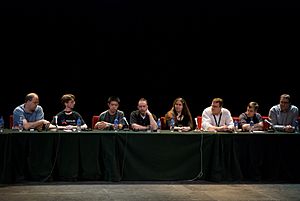Wikimedia Foundation facts for kids
 |
|
| Abbreviation | WMF |
|---|---|
| Founded | June 20, 2003 St. Petersburg, Florida, U.S. |
| Founder | Jimmy Wales |
| Type | 501(c)(3), charitable organization |
| Focus | Free, open-content, wiki-based Internet projects |
| Location |
|
|
Area served
|
Worldwide |
| Products | Wikipedia, Wiktionary, Wikimedia Commons, Wikidata, Wikiquote, Wikibooks, Wikisource, Wikispecies, Wikinews, Wikiversity, Wikivoyage, MediaWiki |
|
Membership
|
Board-only |
|
Key people
|
María Sefidari (Chair of the board) Katherine Maher (Executive director) |
|
Revenue
|
|
| Expenses |
|
| Endowment (2019) | US $35 million |
|
Employees
|
~301 staff/contractors (as of August 8, 2018[update]) |
The Wikimedia Foundation is a special kind of organization called a non-profit foundation. This means it doesn't try to make money for owners. Instead, any money it gets goes back into running its projects. Its main office is in San Francisco, United States.
The Wikimedia Foundation runs many online projects. These projects use a special idea called a "wiki" and a software called MediaWiki. A wiki lets many people work together to create and edit content. Some of their most famous projects include Wikipedia, Wiktionary, and Wikimedia Commons.
Other projects supported by the Foundation are Wikiquote, Wikisource, Wikinews, Wikibooks, Wikiversity, Wikidata, and Wikivoyage. There are also smaller wikis related to the Foundation, like the MediaWiki wiki and the Wikimania wiki.
Contents
Starting the Wikimedia Foundation
The Wikimedia Foundation was officially started by Wikipedia co-founder Jimmy Wales. He announced its creation on June 20, 2003. Before this, Wikipedia was run by his company, Bomis. The Foundation was created to help these projects grow and stay free for everyone.
How the Foundation Gets Money
Since the Wikimedia Foundation is a non-profit, it mostly gets its money from donations. People from all over the world donate small amounts to help keep the projects running. The Foundation also looks for grants, which are like gifts of money from other organizations.
Sometimes, companies help by giving free computer hardware or by hosting the servers. Servers are powerful computers that store all the information for the wiki projects. Because people can write and edit the wikis for free, Wikimedia projects are also free for anyone to use. The money collected is used to pay for these servers and to pay the staff who work for the Foundation. In 2013, the Foundation had about 160 employees.
Leaders of the Foundation
Over the years, different people have led the Wikimedia Foundation.
- In 2013, Sue Gardner was the executive director. The executive director is like the main boss who manages the daily work.
- In 2015, Patricio Lorente was the Chair of the Wikimedia Foundation Board. The Chair leads the Board of Directors.
- In 2016, Katherine Maher became the executive director.
- In 2018, María Sefidari became the Chair of the Board.
Understanding the Boards
The Wikimedia Foundation has different groups of people who help guide it.
Board of Trustees

The Board of Trustees is in charge of all the important decisions for the Foundation. There are ten members on this board:
- Four members are chosen by the Board itself.
- Three members are chosen by the community of people who work on the different Wikimedia projects.
- Two members are chosen by local groups and organizations that support Wikimedia.
- One special member is the founder, Jimmy Wales, who is called an "emeritus" member.
In 2019, two new trustees were chosen:
- Nataliia Tymkiv (user:antanana)
- Shani Evenstein (user:Esh77)
Advisory Board
The Foundation also has an Advisory Board. This is a group of experts from around the world. They offer helpful advice to the Foundation on many topics. These topics include legal matters, how to organize the Foundation, technology, rules, and how to reach out to more people.
- You can learn more about how the Foundation is run on the Governance wiki.
Images for kids
-
Wikimedia Foundation post-SOPA party, 2012
See also
 In Spanish: Fundación Wikimedia para niños
In Spanish: Fundación Wikimedia para niños







